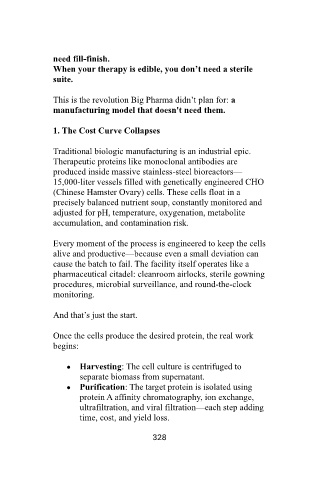Page 330 - Binder2
P. 330
need fill-finish.
When your therapy is edible, you don’t need a sterile
suite.
This is the revolution Big Pharma didn’t plan for: a
manufacturing model that doesn't need them.
1. The Cost Curve Collapses
Traditional biologic manufacturing is an industrial epic.
Therapeutic proteins like monoclonal antibodies are
produced inside massive stainless-steel bioreactors—
15,000-liter vessels filled with genetically engineered CHO
(Chinese Hamster Ovary) cells. These cells float in a
precisely balanced nutrient soup, constantly monitored and
adjusted for pH, temperature, oxygenation, metabolite
accumulation, and contamination risk.
Every moment of the process is engineered to keep the cells
alive and productive—because even a small deviation can
cause the batch to fail. The facility itself operates like a
pharmaceutical citadel: cleanroom airlocks, sterile gowning
procedures, microbial surveillance, and round-the-clock
monitoring.
And that’s just the start.
Once the cells produce the desired protein, the real work
begins:
● Harvesting: The cell culture is centrifuged to
separate biomass from supernatant.
● Purification: The target protein is isolated using
protein A affinity chromatography, ion exchange,
ultrafiltration, and viral filtration—each step adding
time, cost, and yield loss.
328

